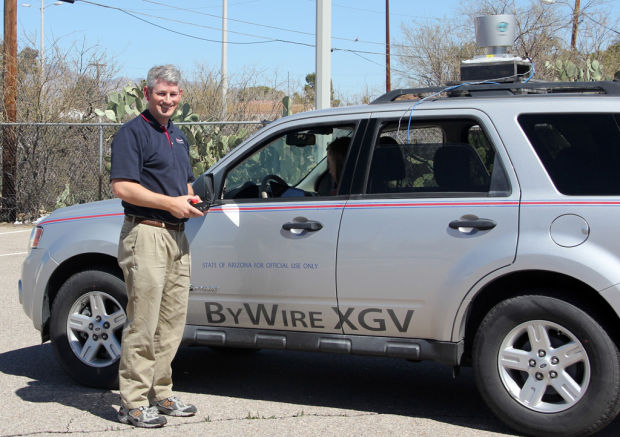
Two University of Arizona professors have won early-career awards from the National Science Foundation for pairing cutting-edge research with novel teaching tools that involve younger students in science and engineering.
Jonathan Sprinkle, an assistant professor of electrical and computer engineering, has a cool tool for luring students as early as high school into writing software code - the chance to command a driverless full-sized vehicle.
This summer, 10 undergraduate university students are helping Sprinkle write code that will allow students at two local high schools to safely pilot a Ford Explorer hybrid using little more than a cellphone app.
Sprinkle has a greater purpose in mind - systems that will cut the development time for complex computer-controlled machines.
“Domain-specific modeling,” which attempts to predict and solve problems during the design phase, has been successful in software modeling, he said. The next step is to extend that success to cyber-physical systems in which the software is married to the physical world.
He said he saw the grant opportunity from the NSF as a “challenge to do something to change how other people do their work.”
Shirley Papuga, meanwhile, has devised a framework for looking at the complicated interactions between surface and subsurface water and the plants that rely on it.
Papuga, a hydrologist and assistant professor in the School of Natural Resources and Environment, has her students focus on what happens when water is present in one of the areas or is present in both or neither. With those four possibilities, students can design experiments for greenhouse labs and remote sensors in the field.
Papuga says she encourages her undergraduate and graduate students to participate in all phases of research, from field to lab to data crunching, to gain a full understanding of the hypotheses they explore.
“It’s an educational tool in addition to being cutting-edge research,” she said. “It’s simple enough to allow them to generate clean hypotheses.”
The awards, which carry up to $500,000 over five years, are designed to put young professors on a trajectory that combines research and teaching, said Papuga.
She currently supervises the work of three undergraduates and give graduate students in her lab. The NSF grant will ease some of the perpetual scramble for grant money to support them. She expects to support one full-time grad student and five more undergrads with the funding.
Sprinkle will use the grant to expand his programs that give research experience to undergraduates and to bring that experience to high school classrooms (or school parking lots) as well.
On StarNet: Find more education and UA news and resources at azstarnet.com/education
“It’s an educational tool in addition to being cutting-edge research. It’s simple enough to allow them to generate clean hypotheses.”
Shirley Papuga, a hydrologist and assistant professor in the School of Natural Resources and Environment
The awards, which carry up to $500,000 over five years, are designed to put young professors on a trajectory that combines research and teaching.
****************************************
Young University of Arizona Professors Honored for Outside-the-box Ideas,






